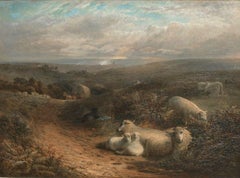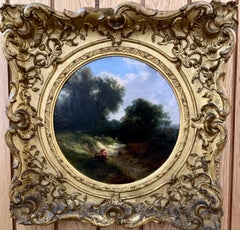George Cole On Sale
19th Century Realist Landscape Paintings
Oil
19th Century Portrait Paintings
Oil, Canvas
Recent Sales
1870s English School Landscape Paintings
Oil
1850s Victorian Landscape Paintings
Oil, Canvas
People Also Browsed
Mid-19th Century Victorian Landscape Paintings
Oil, Wood Panel
Mid-18th Century Old Masters Landscape Paintings
Oil
Late 19th Century Old Masters Landscape Paintings
Canvas, Oil
Mid-19th Century Victorian Landscape Paintings
Oil, Canvas
17th Century Old Masters Paintings
Oil
Late 20th Century Photorealist Landscape Paintings
Canvas, Oil
Mid-19th Century Realist Landscape Paintings
Oil
Antique 19th Century Belgian Paintings
Canvas, Wood, Giltwood, Paint
19th Century Victorian Landscape Paintings
Canvas, Oil
19th Century Victorian Landscape Paintings
Canvas, Oil
19th Century Victorian Landscape Paintings
Oil
19th Century Victorian Landscape Paintings
Canvas, Oil
19th Century Victorian Landscape Paintings
Oil, Canvas
19th Century Victorian Landscape Paintings
Oil
19th Century Victorian Landscape Paintings
Oil, Canvas
1890s Victorian Landscape Paintings
Oil
George Cole for sale on 1stDibs
George Cole was a portrait landscape and animal painter in oils. He was the father of George Vicat Cole. Cole was born in Portsmouth to James and Elizabeth Cole. His mother died when he was nine years old. According to the artist's grandson, Rex Vicat Cole, he was apprenticed to a ship's painter in the Royal Navy dockyards at Portsmouth. He taught himself to paint pictures, at first portraits and animals; he also painted posters for Wombwell's menagerie. In 1838, Cole's painting The Farm Yard was shown at the Society of British Artists. When he was 30, he changed his focus to landscapes and received instruction from John Wilson and started exhibiting in 1840. One anecdote has him painting the portrait of a Dutch merchant in Portsmouth. After the sitter refused to pay him, saying it was a bad likeness, Cole added wings and put the painting in a shop window with the title The Flying Dutchman. The man's friends recognized him and laughed; he paid for the painting and Cole painted out the wings. His career has been regarded as a good example of the Victorian self-made man. In 1831, he married Eliza Vicat, of an old French Huguenot family. In 1852, he moved to Fulham and in 1855 to Kensington, where he lived for the rest of his life. In the mid-1860s, he purchased Coombe Lodge, a small estate in Hampshire. In a series of richly colored and detailed landscapes on large canvases executed during the 1860s and 1870s, Cole created an idealized version of the Hampshire moorlands and agricultural landscape; examples include Fern Karting, Harting Coombe (1873, Russell-Cotes Art Gallery and Museum, Bournemouth). Cattle continued to play an important role in his compositions and he specialized in the depiction of river scenery with cows watering, including, for example, Windsor Castle. Although he exhibited 16 works at the Royal Academy, Cole's work formed a mainstay of the exhibitions of the Society of British Artists at Suffolk Street, where he exhibited 209 paintings from 1838 until he died in 1883. He was elected a member in 1850, became an auditor in 1856 and vice-president in 1867. He was also awarded a medal for a harvesting scene in 1864 by the Society for the Encouragement of the Fine Arts. George Cole died on 7 September 1883 at his home at 1 Kensington Crescent and was buried in Kensal Green Cemetery, London.
Finding the Right Paintings for You
Painting is an art form that has spanned innumerable cultures, with artists using the medium to tell stories, explore and communicate ideas and express themselves. To bring abstract paintings, landscape paintings, still-life paintings and other original paintings into your home is to celebrate and share in the long tradition of this discipline.
When we look at paintings, particularly those that originated in the past, we learn about history, other cultures and countries of the world. Like every other work of art, paintings — whether they are contemporary creations or works that were made during the 19th century — can often help us clearly see and understand the world around us in a meaningful and interesting way.
Cave walls were the canvases for what were arguably the world’s first landscape paintings, which depict natural scenery through art. Portrait paintings and drawings, which, along with sculpture, were how someone’s appearance was recorded prior to the advent of photography, are at least as old as Ancient Egypt. In the Netherlands, landscapes were a major theme for painters as early as the 1500s. Later, artists in Greece, Rome and elsewhere created vast wall paintings to decorate stately homes, churches and tombs.
Today, creating a wall of art is a wonderful way to enhance your space, showcase beautiful pieces and tie an interior design together.
No matter your preference, whether you favor Post-Impressionist paintings, animal paintings, Surrealism, Pop art or another movement or specific period, arranging art on a blank wall allows you to evoke emotions in a room while also showing off your tastes and interests. A symmetrical wall arrangement may comprise a grid of four to six pieces or, for an odd number of works, a horizontal row. Asymmetrical arrangements, which may be small clusters of art or large, salon-style gallery walls, have a more collected and eclectic feel.
Download the 1stDibs app, which includes a handy “View on Wall” feature that allows you to see how a particular artwork will look on a particular wall, and read about how to arrange wall art. And if you’re searching for the perfect palette for your interior design project, what better place to turn than to the art world’s masters of color?
On 1stDibs, you’ll find an expansive collection of paintings and other fine art for your home or office. Browse abstract paintings, portrait paintings, paintings by emerging artists and more today.


